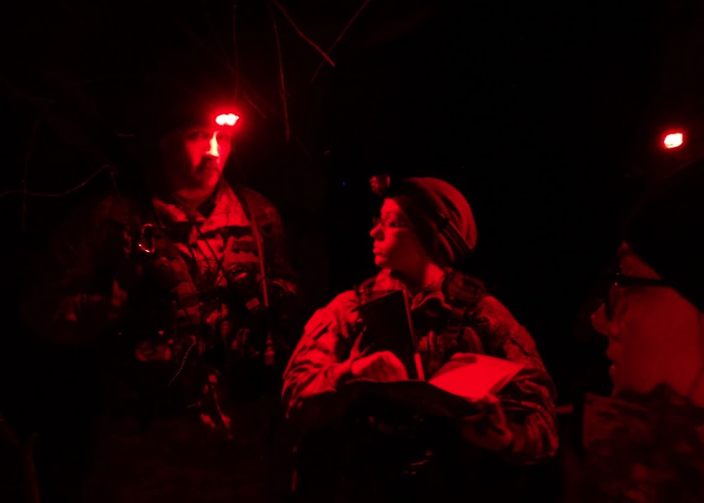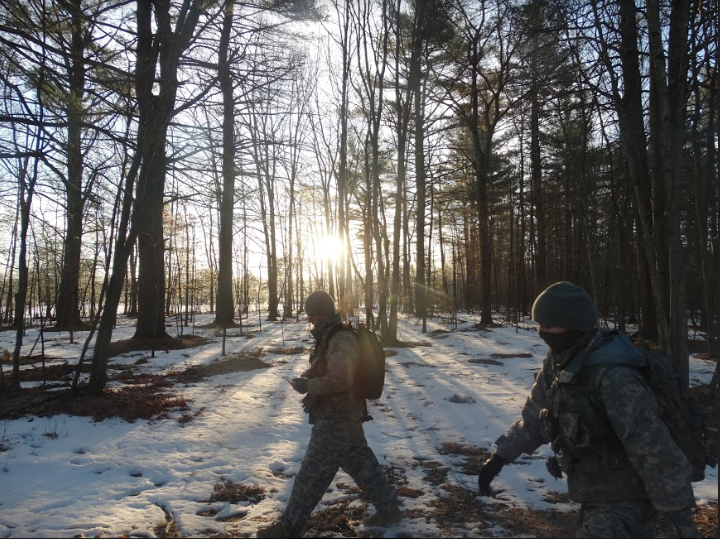Inside an ROTC field training exercise
April 27, 2017
FORT DEVENS — On a sunless Friday morning at the University of Massachusetts Amherst, the silence shattered with the thunder of aircraft. In the soggy field by the recreation center, a pair of Chinook helicopters set down and opened their hatch doors.
Waiting on the sidelines were Lt. Col. Stephen Magner, one of the leaders of the UMass Minuteman Battalion, and a selection of his cadets, all fully rucked and geared up for what was to come.
Lt. Col. Magner gave his signal. The cadets, now all sworn in or soon-to-be sworn in members of the United States Military, marched single file into the maw of the twin rotor helicopter. Their destination was Fort Devens, where a massive joint field exercise (JFTX) involving over 250 cadets from a variety of New England schools would take place.
The rest of the battalion took a bus to the exercise location.
The ride had an atmosphere of a school field trip. Some cadets drank energy drinks while others napped. A few passed around a can of chewing tobacco and joked around to pass the time.
The air was cold and the ground was blanketed in a thin layer of slushy snow as cadets arrived at Fort Devens.
Each cadet was issued a genuine M16 rifle, albeit with fake bullets, or blanks, and a cap over the barrel. The rifles weighed about 8 pounds. This may not seem like much, but with a fully-loaded rucksack on their backs and days of hiking ahead of them, the cadets would definitely notice the weight.
Other cadets were issued M249s, a light machine gun weighing around 17 pounds without ammunition. Instead of the standard platoons from each battalion, the schools were mixed up and shuffled to force cadets to work with unfamiliar faces.
After a final hot meal, the sun started to set. As the platoons were assembled, I asked UMass Cadet Brad Cassidy, one of the fourth year cadets, or MS4s, where I should be. He glanced around before his eyes found his target.
Cassidy grinned and grabbed the attention of another MS4 named Mathew Duffy. Duffy groaned and swore jokingly after hearing “the reporter” would accompany him. Duffy’s gruff and pessimistic demeanor is well-known across the battalions. He told me strangers will even approach him and tell him to smile.
Despite his reputation, Duffy was friendly and more than willing to talk. He was with second platoon bravo, so I followed them as they marched into the forest to spend the night.
As we hiked out a few hundred yards from the Turner Drop Zone where the buses had arrived, I saw Duffy was carrying a rocket launcher. He told me me it was an AT4. The one he carried was real, but once the rocket launcher is fired it will not work again.
“It used to be cool, but not anymore,” Duffy said.
The first night in the woods was a frigid one.
At 4 a.m, second platoon awoke on the snowy ground. The sky was stained deep, dark blue. It took a few hours for the platoon to pack up their shelter and situate themselves. They swapped the rucks for smaller assault packs, leaving the cumbersome, heavy bags covered by ponchos. By the time the platoon was ready to go, the sun had made a full return.
The first lane, or exercise, was designed to practice reconnaissance, which consists of covertly surveying a hostile group — making observations and bringing those back to the rest of the platoon. The location of the exercise was several hundred meters away from us, so a land navigation took up the first half of the morning.
The group pushed through a frozen marsh, making movement especially slow for a large group. There were 35 cadets in second platoon.
“Getting them going is the hardest part,” Major Nathan Aube said.
Second platoon reached a pair of small hills with a path down the middle. Cadets took cover behind trees. The target reconnaissance site was apparently just over the hill to our right. A smaller team was picked to pull off the actual observation. They were quickly spotted by the “Op For,” or opposing force, played by other MS4 cadets.
The platoon reconvened at the enemy base to assess what they learned.
The enemy base was a rudimentary shelter built of a few stretched out ponchos as roofs, with logs jammed under them as support beams. Occupying it were the “hostile” MS4s, armed with rubber AK-47s and a rubber rocket-propelled grenade launcher (RPG). The group was dressed in black jackets that simply said, “OP FOR” in black and white letters. A few of the Op For members chuckled about how elaborate their shelter got, seeing as they had been waiting to be discovered by second platoon for hours.
Cadet Tyler Martin, a student from the University of Connecticut, was playing as an Op For and explained the roleplaying aspect is drawn from a massive 800-page rulebook.
The next few hours were spent trudging up and down hills, sprinting across roads in attempt to reach the second lane: an ambush.
Major Aube tried to motivate the tired troops as a light rain fell. He tossed what I would call an firecracker on steroids behind the group. The battalion sprinted 100 meters away. These “firecrackers” are meant to simulate a mortar shell coming down.
A few more blasts thundered out from somewhere else on the property. But these were real. Somewhere else on the property, real explosives were being tested on the base in a fenced off area separate from the ROTC exercise. Aube used this to his advantage, having the cadets sprint each time a blast sounded. By the time second platoon reached their objective, the chance for the ambush had passed.
People were tired, their socks were soaked, and the sun still hadn’t come out.
The ambush wasn’t going to happen.
The final lane was the Key Leader Engagement (KLE), another role playing exercise. The objective was to peacefully interact with the leader of a mock “village” made up of other cadets. The goal was to convince the village to support U.S. forces.
“They’ll hopefully break bread, work something out nice and it all goes off without a hitch,” Duffy said.
But there was a hitch.
Cadet Jackson Wainwright was tasked with leading the platoon for the exercise. Like the enemy base from lane one, participants were played by other cadets.
The village consisted of an “elder” in a red head scarf, and three “villagers” armed with rubber guns again. Wainwright gave the elder a bag of Skittles and they talked about challenges faced by the village.
While Wainwright talked with the elder, his platoon made a perimeter around the small village. The villagers mingled and talked with the cadets, testing them. One villager even managed to pop a magazine out of a guarding cadets rifle. As it turned out, the cadre had decided to make the village a bit more hostile than the platoon had anticipated.
The village elder’s son came back to the hut, and pulled out a hidden rocket-propelled grenade and fired it. This would have killed everyone inside. Because there was no real rocket, there was no big boom, and a lot of cadets didn’t notice the incident.
Major Aube tossed another firecracker. The blast scattered the platoon around the village, and after a long standoff, the cadets opened fire on the now-hostile villagers.
The exercise was over. One lesson was very clear: Anything can happen in a warzone, regardless of the plan.
“Skittles are delicious but they aren’t always gonna cut it,” Aube said.
Email Jon at [email protected] or follow him on Twitter @Jon_H_Decker.

